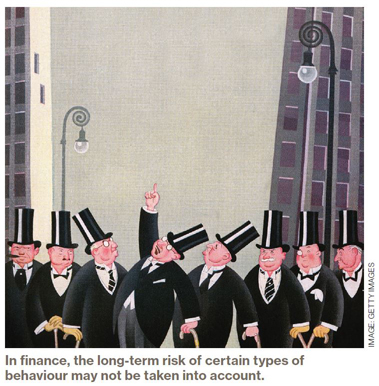Many people believe that the finance sector is contributing disproportionately to income inequality in our society. Do you agree?
I do. Ever since the 1980s, compensation in finance has been higher and more skewed than in other sectors. It has been shown that the ‘finance wage premium’ — the degree to which finance salaries exceed those in other industries — is, on average, 50 per cent. That is why the sector has been criticized as one of the sources of growing income inequality.
My colleagues and I felt that this public debate called for an improved understanding of the drivers of bankers’ pay. Our intuition told us that one of the key drivers is the competition for talent. For our research, we defined talent as, ‘the aptitude to reach an objective in a competitive environment’. In this definition, talent encompasses not only cognitive skills, but also personality traits such as motivation, self-discipline, low cost of effort, and ability to perform in a competitive environment. We set out to answer two questions: Are wage returns to talent relatively high in finance compared to the rest of the economy?; and, Do talent effects drive the cross-section of wages observed in finance?
Our main finding was that the finance wage premium has indeed been disproportionately allocated to the most talented individuals in this sector: returns to talent were three times higher in finance than in the rest of the economy. We also discovered that, while wages have increased a lot in the finance sector overall, they have increased even more for the top percentile in the sector. The most talented individuals in finance have thus received most of the available wage increases in recent decades. We believe these significant returns are also associated with an increasing share of talented individuals choosing to go into finance
occupations.
Our results contribute to the overall understanding of the well-documented rise in income equality. While these outcomes may be both meritocratic and economically efficient in the short run — they might not be socially or politically sustainable in the long run.
Within finance, you found that returns-to-talent for ‘front-office’ jobs are even higher when compared to back office or ‘support’ departments. Please discuss this finding.
We found that indeed, returns to talent are higher for front-office jobs like traders or quants, relative to ‘back-office’ roles such as risk managers, and there are two possible reasons for this.
The first is that talent is more scalable in front-office jobs. If you are a highly talented trader, the cost of managing a portfolio of ten million dollars is not much higher than the cost of managing a portfolio of two billion dollars. The work itself is very scalable: depending on how talented you are, you can adjust the size of your portfolio with relatively low cost. Whereas, if you are a risk manager, you can’t suddenly start analyzing three times as many securities without taking a lot more time, which costs more.
It is also easier to measure your short-term performance as a front-office worker, because you can measure the performance of your portfolio and how many securities you have sold; but when you are a risk manager or any other back office job, the focus is more on long-term performance. In short, the more transparency there is around confirming great performance, the higher the competition for talent.
Banks may be competing for talent based on short-term performance, so there may be negative externalities involved.
In a world where finance wage returns to talent are more than three times higher than in the rest of the economy, what is your message for finance executives?
As indicated, banks may be competing for talent based on short-term performance, so there may be negative externalities involved — in the sense that the long-term risk of certain types of behaviour may not be taken into account. As a manager of finance talent, you should be looking at the long-term impact of your decisions.
In your view, should bankers’ pay be regulated?
I don’t think that is the answer, because a cap on wages would only encourage the development of a more opaque and complex system. Also, if these sky-high wages result from competition for talent — which we believe they do — banks will just find other another way to pay these people. They might just provide them with fancy cars or bigger bonuses; or, more people might just go abroad to work. There have actually been some laws putting a cap on bonuses, but that has only resulted in higher fixed wages. I would like to do more research on this, because quantifying the negative externalities of higher returns to talent
— if indeed they exist — is difficult. In addition, any answer could create new distortions. For example, higher taxes could be considered as part of the solution. The government could take income inequality into account when setting tax rates; but increasing taxes could also lead to a brain drain to countries with lower tax regimes.
In other research, you looked at the ‘unbanked’ population, to investigate whether the finance sector is meeting the needs of poor families. What were your key findings?
People might not recognize that this is a huge chunk of the population: in the U.S., 35 to 45 per cent of low-income households are ‘unbanked’ — which means that they possess neither a chequing nor a savings account. We were interested in whether this is driven by supply- or demand-side factors.
The ‘demand-side’ view attributes the unbanked phenomenon to cultural determinants (i.e. the poor may distrust financial institutions or may not have a ‘culture of saving’) or to a lack of financial literacy. Alternatively, the ‘supply-side’ view suggests that standard bank practices create hurdles for the poor: minimum account balances, overdraft fees, a large distance between branches and the proliferation of formal steps to open an account result in costs that may be too high for poor households to manage. Furthermore, bank services may not be tailored to low-income households.
Of course, these two polar explanations have different policy implications. The demand-side view would require interventions at the household level, through financial literacy programs, for example, while the supply-side view suggests that giving banks incentives to change their behaviour towards these customers may reduce the share of unbanked households.
We found clear evidence of a supply issue. In our study, an increase in the density of bank offices in poor counties had a positive impact on the share of low-income households with a bank account. We also found that interstate branching deregulation is associated with a significant drop in the rate of unbanked households among low-income populations. We observed a significant increase in the share of banked households following deregulation.
We also found that having access to bank accounts improves wealth accumulation, but does not translate into higher levels of indebtedness. We showed that deregulation impacts neither the probability to incur debt nor the debt-to-income ratio of low income households, which mitigates the fear that banking competition fosters ‘predatory lending’.
 You also studied the sale of complex financial products; what were your key findings?
You also studied the sale of complex financial products; what were your key findings?
Since the end of the 1990s, European financial institutions have designed, marketed and sold more than two trillion euros worth of complex financial products to households — so-called ‘retail structured products’. The marketing for these products typically focuses on the return they offer under the best-case scenario, which is known as the ‘headline rate’. In parallel, in the U.S. and in Canada, the market of structured deposits, which are a sub-category of retail structured products, is becoming increasingly popular.
In our study, we documented three basic facts about the retail market for structured products. First, product complexity increased significantly from 2002 to 2010, with no discernible drop during the global financial crisis. Second, the fraction of products exposing investors to complete losses increased significantly over our sample period. Third, headline rates departed more from the level of interest rates when interest rates were low.
There are two theories of the determinants of security design: first, risk sharing; and second, banks catering to yield-seeking investors through complexity and shrouding (i.e. concealing) information. The results of our study are consistent with financial complexity being a by-product of banks catering to yield-seeking investors: we found that products offering high headline rates and products exposing investors to complete losses are more complex. Second, the spread between product headline rates and interest rates increases when interest rates are low, as do product complexity and risk. Third, both products offering a high headline rate and more complex products yield higher markups to the banks that issue them. These higher markups translate into lower performance for more complex products.
Complexity is often said to go hand-in-hand with financial innovation. Do you agree?
No, I don’t. I think the perfect innovation would improve risk sharing, complete markets and better match consumer needs, without any complexity. I would actually love a world where financial innovation comes without complexity!
What are you working on these days?
I have a few projects underway. I am continuing my work on complexity in finance — looking at who exactly is buying all of these retail structured products. I also have another project on the go related to unbanked households, where we look at the effect on these individual financial situations of having access to health insurance. Then I have projects that are more related to bank regulations in general. In one, we’re looking at the effects of an exogenous shock on bank credit, and what the effect is on employment. How do firms react? It’s still quite preliminary — but I will be happy to share my results with your readers in the near future!
Claire Celerier is an Assistant Professor of Finance at the Rotman School of Management. Before joining Rotman in July 2016, she was an Assistant Professor at the University of Zurich.
In 2018, Rotman faculty research was ranked #10 globally by the Financial Times.